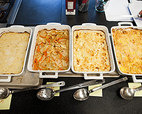Why this recipe works:
Our root vegetable gratin pairs the earthy flavor of potatoes with
thinly sliced sweet rutabaga and savory celery root. We allow these
flavors to come to the fore by adding just a few aromatics: onion,
garlic, thyme, and Dijon mustard. We add white wine to the gratin
because the wine’s acidity strengthens the pectin in the potatoes so
that they remain intact while the denser, less-starchy rutabaga and
celery root cook through; the wine also brightens the flavor of the
vegetables. To help the top layers of the gratin cook through at the
same rate, we cover the dish for the first portion of the cooking time. A
layer of Parmesan-enhanced panko bread crumbs added after the foil is
removed toasts while the gratin finishes cooking, adding a crispy,
golden crust that is nutty and cheesy in flavor.
Serves 6 to 8
Uniformly thin slices are necessary for a cohesive gratin. We recommend a mandoline for quick and even slicing, but a sharp chef’s knife will also work. Because the vegetables in the gratin are tightly packed into the casserole dish, it will still be plenty hot after a 25-minute rest.Ingredients
- 1 tablespoon plus 1 1/2 cups water
- 1 1/2 teaspoons Dijon mustard
- 2 teaspoons all-purpose flour
- Salt and pepper
- 2/3 cup dry white wine
- 1/2 cup heavy cream
- 1/2 onion, chopped fine
- 1 1/4 teaspoons minced fresh thyme
- 1 garlic clove, minced
- 2 pounds Yukon Gold potatoes, peeled and sliced lengthwise 1/8 inch thick
- 1 large celery root (1 pound), peeled, quartered, and sliced 1/8 inch thick
- 1 pound rutabaga, peeled, quartered, and sliced 1/8 inch thick
- 3/4 cup panko bread crumbs
- 1 1/2 ounces Parmesan cheese, grated (3/4 cup)
- 4 tablespoons unsalted butter, melted and cooled
Instructions
-
1. Adjust oven rack to middle position and heat oven to 375 degrees. Grease 13 by 9-inch baking dish. Whisk 1 tablespoon water, mustard, flour, and 1 1/2 teaspoons salt in medium bowl until smooth. Add wine, cream, and remaining 1 1/2 cups water; whisk to combine. Combine onion, thyme, garlic, and 1/4 teaspoon pepper in second bowl.
2. Layer half of potatoes in prepared dish, arranging so they form even thickness. Sprinkle half of onion mixture evenly over potatoes. Arrange celery root and rutabaga slices in even layer over onions. Sprinkle remaining onion mixture over celery root and rutabaga. Layer remaining potatoes over onions. Slowly pour water mixture over vegetables. Using rubber spatula, gently press down on vegetables to create even, compact layer. Cover tightly with aluminum foil and bake for 50 minutes. Remove foil and continue to bake until knife inserted into center of gratin meets no resistance, 20 to 25 minutes longer.
3. While gratin bakes, combine panko, Parmesan, and butter in bowl and season with salt and pepper to taste. Remove gratin from oven and sprinkle evenly with panko mixture. Continue to bake until panko is golden brown, 15 to 20 minutes longer. Remove gratin from oven and let stand for 25 minutes. Serve.
Technique
Firming Up Potatoes with Wine
The wine in our root vegetable gratin brightens the flavor of this typically starchy-tasting dish, but more important, it also prevents the potatoes from breaking down and turning mushy while the denser celery root and rutabaga cook. Here’s how it works: Potato cells have an abundance of starch granules; when these granules swell with water during cooking, they press against the cell walls, eventually causing them to burst and release starch. But when potatoes cook in water with wine, the wine lowers the pH, which strengthens the pectin in and around the cell walls, helping them resist bursting. The upshot is a pliable, not mushy, potato.
Of course, the acid also strengthens the pectin in the celery root and rutabaga, but since they contain less starch than potatoes, the acid’s effect on them is less noticeable.
To demonstrate acid’s effect on potatoes, we simmered two batches of 1/8-inch-thick potato slices, one in plain water and the other in 1 1/2 cups of water acidulated with 2/3 cup of white wine. After just 10 minutes of simmering, the potatoes cooked in plain water fell apart, while those cooked in acidulated water remained whole and firm but pliable.

PLIABLE, NOT MUSHY: Cooking potatoes in water with wine strengthens their cell walls, so they resist bursting as they cook.
Technique
Recipe Testing: Four that Failed

In our quest for the best gratin, we tried recipes featuring a range
of vegetable preparations: shredded, sliced, cubed, and mashed. But not
one lived up to our idea of what a good gratin should be—either because
the vegetables were unevenly cooked, the sauce was sticky or soupy, or
the flavor was dull and heavy.





















0 comentarios:
Publicar un comentario